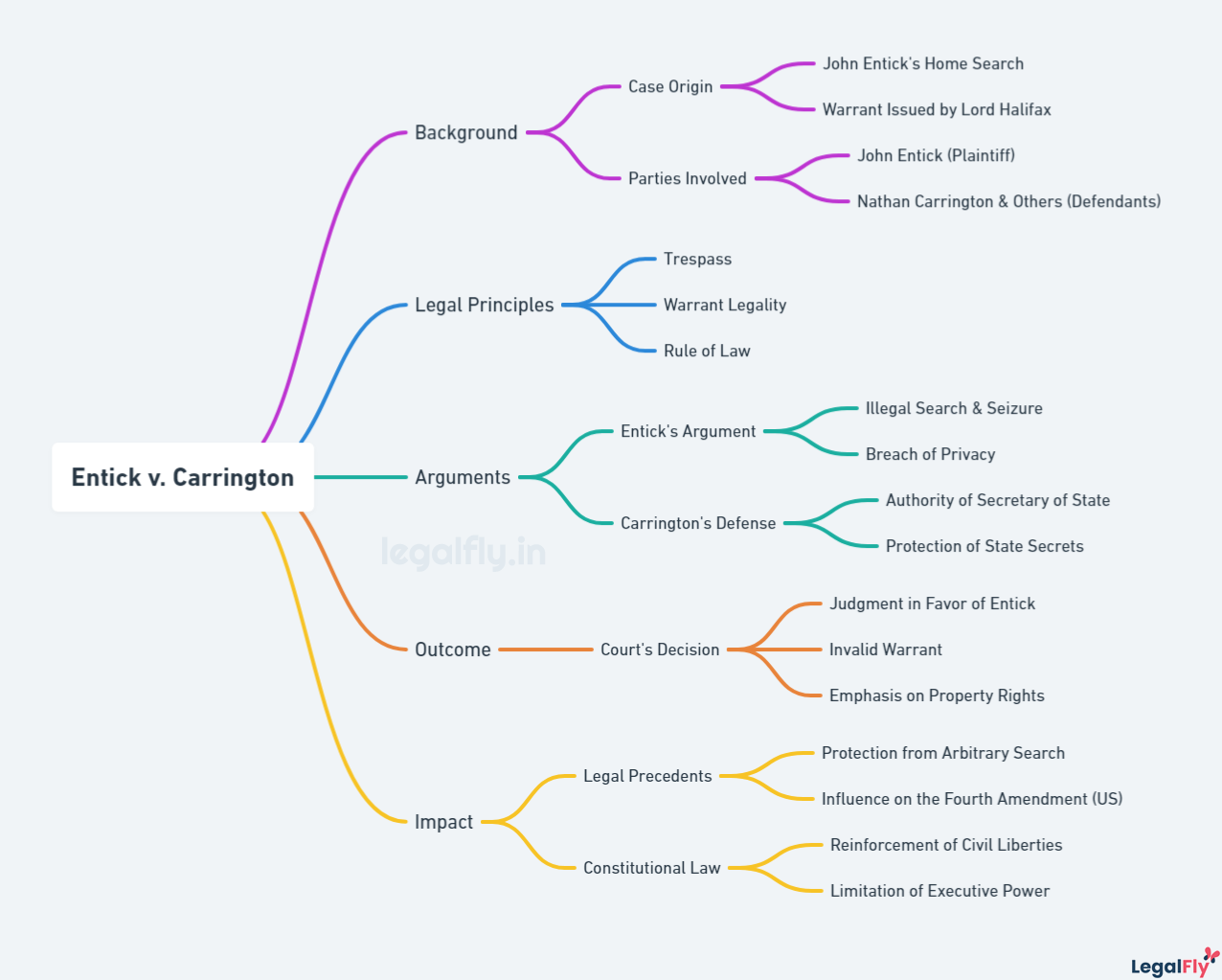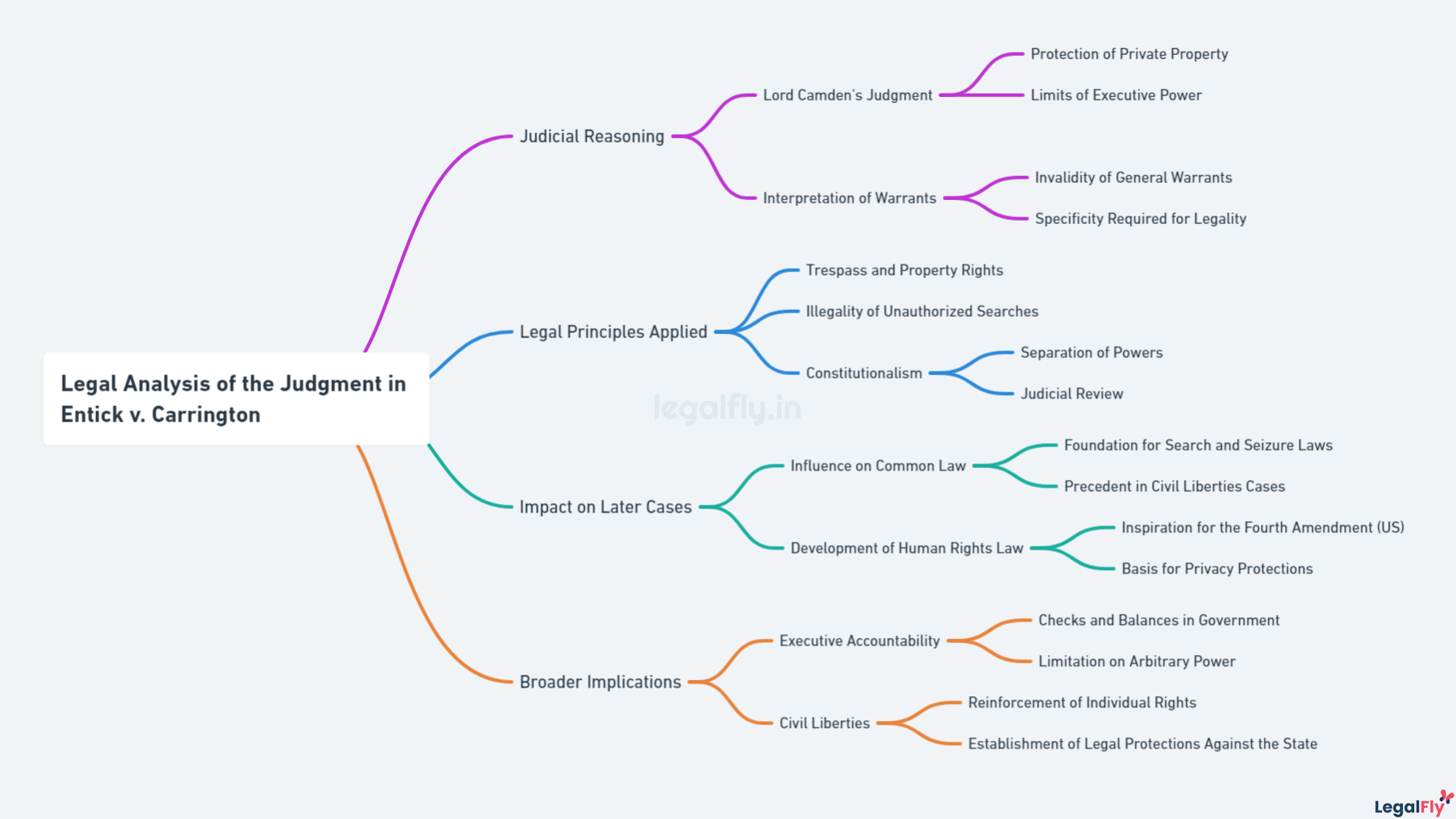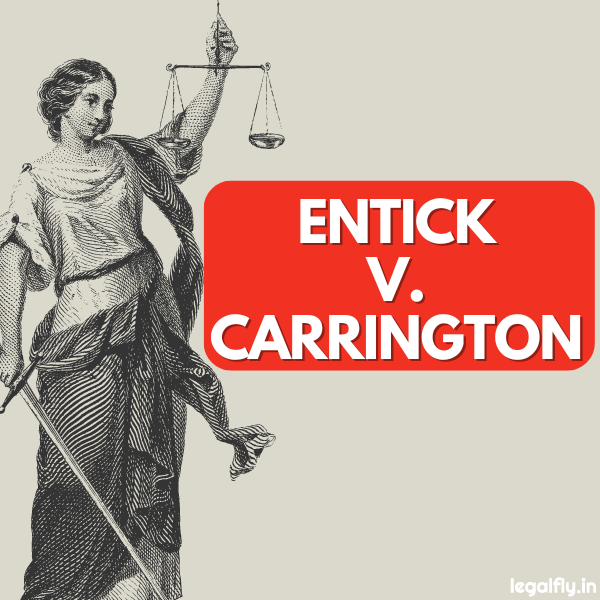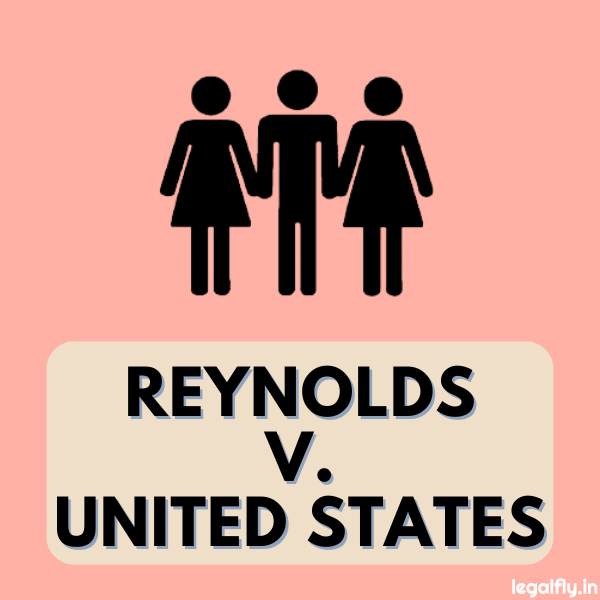Table of Contents
Case Name: Entick v. Carrington
Court: Court of King’s Bench
Year: 1765
Citation: (1765) 19 St Tr 1030
Introduction to Entick v. Carrington
Entick v. Carrington (1765) is a landmark English legal case that established the civil liberties of individuals and limited the scope of executive power. It was one of the most important decisions of the 18th century concerning unreasonable search and seizure.

The case arose when agents of the King raided the home of John Entick, a writer, in November 1762 and seized his papers and documents in a search for the author of pamphlets critical of the Crown. Entick sued for trespass against the agents. In an 11-1 verdict, the court ruled that the general warrant authorizing Entick’s home to be searched was unlawful as it was too broad and indefinite.
Lord Camden’s judgment asserted that “every invasion of private property, be it ever so minute, is a trespass” and that general warrants were “totally subversive of the liberty of the [subject]”. He eloquently stated that “the great end for which men entered into society was to secure their property” and that “every man’s house is looked upon by the law to be his castle of defence and asylum.”
The principles established in Entick v. Carrington had a profound influence on English law. Most significantly, the case has been described as a foundation of English constitutional law for establishing judicial oversight of executive power. It also shaped legal thinking in British colonies like America, with the presiding judge Lord Camden’s ruling providing motivation for the Fourth Amendment to the United States Constitution.
The Facts of Entick v. Carrington
The case of Entick v. Carrington arose from an unlawful search and seizure of private property in 18th-century England. The key figures were John Entick, the plaintiff, and Nathan Carrington, an official of the King’s Messengers.
In November 1762, Carrington and three other messengers acting under a warrant from the Earl of Halifax, then Secretary of State, broke into Entick’s home and seized papers and books on suspicion of seditious libel. The warrant was a general warrant that gave broad authority to search unspecified places and seize unspecified items without requiring probable cause or naming Entick specifically.
Entick sued Carrington and the other messengers for trespassing against his home and stealing his personal possessions. The case thus centered on the legality of the government’s actions and the limits on state power versus individual civil liberties. Entick asserted his rights as a freeborn Englishman to privacy, property, and freedom from unreasonable searches. Carrington claimed authority under the warrant and his role as a Crown official.
The unlawful raid on Entick’s home and the questionable legality of the general warrant set the stage for a pivotal constitutional case. Entick v. Carrington confronted fundamental questions about the balance of state power and civil liberties.
Detailed Account of the Events
The events leading up to the Entick v. Carrington case began in November 1762, when agents of Lord Halifax, one of King George III’s Secretaries of State, raided the home of John Entick in London. Entick was the author and publisher of pamphlets critical of the King’s government. The raid was conducted under the authority of a general warrant issued by Lord Halifax, which gave the agents broad powers to seize Entick’s books and papers.
Specifically, on November 11, 1762, Messengers Nathan Carrington and three others entered Entick’s home and remained there for four hours searching through his possessions. They broke open locks, chests, and drawers and seized all of Entick’s papers and books. This included not only potentially seditious publications but also Entick’s private papers and correspondence. The warrant under which they acted claimed authority to seize any papers connected to Entick without specifying what was being sought in particular.
Lord Halifax directly authorized the raid on Entick’s home and the seizure of his possessions as a way to try to suppress and prosecute publications critical of the Crown. However, Entick and his lawyers argued that this sweeping warrant and the actions carried out under it were illegal violations of Entick’s property rights. This set up the legal battle that became the Entick v. Carrington case.
Legal Analysis of the Judgment
In reaching a verdict, the presiding judge, Lord Camden, conceded that the Earl of Halifax had indeed acted as Secretary of State. However, he could not find “any kind of authority to justify the defendants in what they have done.” Lord Camden ruled that the warrant used to search Entick’s home was unlawful and that Entick’s complaint of trespass was valid.

Lord Camden’s ruling established several key principles regarding state power and individual rights:
- General warrants that do not specify the person or place to be searched are unlawful and invalid. As Lord Camden stated, “If such a power is truly invested in a secretary of state, and he can delegate this power, it certainly may affect the person and property of every man in this kingdom, and is totally subversive of the liberty of the subject.”
- The state and its agents cannot arbitrarily violate an individual’s private property. Entick’s home and papers were protected from unreasonable search and seizure.
- Individuals have a right to privacy and to be free from harassment by officials acting without just cause. As Lord Camden noted, “We can safely say there is no law in this country to justify the defendants in what they have done; if there was, it would destroy all the comforts of society.”
Overall, Lord Camden’s ruling asserted the judicial authority to limit executive power and established vital civil liberties principles that endure today.
Core Legal Issues Addressed
Entick v. Carrington addressed two core legal issues:
- the legality of general warrants and
- the right to privacy and property protection.
Regarding general warrants, Lord Camden ruled that the warrant issued by the Earl of Halifax authorizing the seizure of Entick’s papers was unlawful and void. The Earl’s authority did not extend to issuing such general warrants without probable cause. This helped establish legal precautions against the abuse of state power through unrestricted search and seizure.
The case also affirmed the common law principle that “every invasion of private property, be it ever so minute, is a trespass.” Entick had a legal right to possession of his papers, which could not be forcibly taken except through due process of law. This upheld the right to privacy and protection of property against unjustified intrusion by the state.
Overall, Entick v. Carrington established vital judicial oversight of executive authority and affirmed individual liberties against unwarranted government search and seizure. These principles laid the foundations for modern civil rights jurisprudence.
The Broader Impact of Entick v. Carrington
Entick v. Carrington profoundly influenced subsequent legal decisions and constitutional principles regarding civil liberties. The case played a key role in shaping the Fourth Amendment of the U.S. Constitution, which protects against unreasonable searches and seizures.
Lord Camden’s ruling established firm legal precedents against general warrants and unchecked government power to invade private property. His judgement asserted the rights of individuals to be secure in their persons, houses, papers and effects. This reasoning was highly influential in colonial America, as the colonists resisted intrusions by British authorities.
Entick’s case was frequently cited in legal challenges to general writs of assistance, which were similarly broad warrants used by the British in the colonies. According to the U.S. Supreme Court, Entick was “undoubtedly familiar to every American statesman at the time of the Constitutional Convention”. The principles enshrined in the Fourth Amendment mirror those outlined in Lord Camden’s judgement.
By upholding civil liberties against unwarranted state intrusion, Entick laid the groundwork for key constitutional protections. Its legacy continues to shape our modern understanding of privacy rights and limits on government search and seizure. The case remains a foundational precedent against arbitrary exercises of executive power.
Commentary and Modern Relevance
Entick v. Carrington established important principles regarding judicial review of executive authority that continue to resonate today. The case affirmed the judiciary’s role in checking the executive branch’s power by ruling that general warrants violated civil liberties. This precedent helped shape the concept of judicial review, which allows courts to evaluate the constitutionality of laws and acts carried out by the government.
Several more recent court cases reflect the principles established in Entick v. Carrington regarding privacy, property rights, and protection from unreasonable search and seizure:
- In Katz v. United States (1967), the Supreme Court ruled that the Fourth Amendment protects people, not places, from unreasonable search and seizure, building on Entick’s recognition of privacy rights.
- Kyllo v. United States (2001) cited Entick in the majority opinion, using its principles to determine limits on police use of thermal imaging technology to gather information from inside a private home.
- The 2012 Supreme Court case United States v. Jones referenced Entick in discussing the history of Fourth Amendment protections against government trespass.
- Carpenter v. United States (2018) invoked Entick in its ruling about cell phone location data, analogizing to Entick’s protection of private papers.
Even today, Entick’s precedence on prohibiting unreasonable intrusion by the state continues to influence court rulings upholding civil liberties against modern forms of surveillance and data gathering. Its legacy underscores the judiciary’s vital role in checking executive power.
Conclusion
Entick v. Carrington established precedents that have profoundly and enduringly influenced democratic legal principles. The case helped define civil liberties against state intrusion by ruling that general warrants were unconstitutional.
Lord Camden’s judgement asserted the sanctity of private property and the need to restrain executive authority. He found that the raid on Entick’s home violated English common law, as the state had overreached its powers. The case affirmed that individuals have the right to be free from unreasonable searches and seizures.
Entick v. Carrington played a pivotal role in shaping the Fourth Amendment of the U.S. Constitution, which protects against unreasonable search and seizure. The principles established by the case continue to influence modern legal decisions regarding privacy and due process.
Nearly 260 years later, Entick v. Carrington stands as a landmark case upholding civil liberties and constraining the powers of the state. Its legacy remains vitally relevant to democratic societies seeking to balance executive authority with individual rights. The judgement enshrined ideals that remain central to constitutions worldwide.




